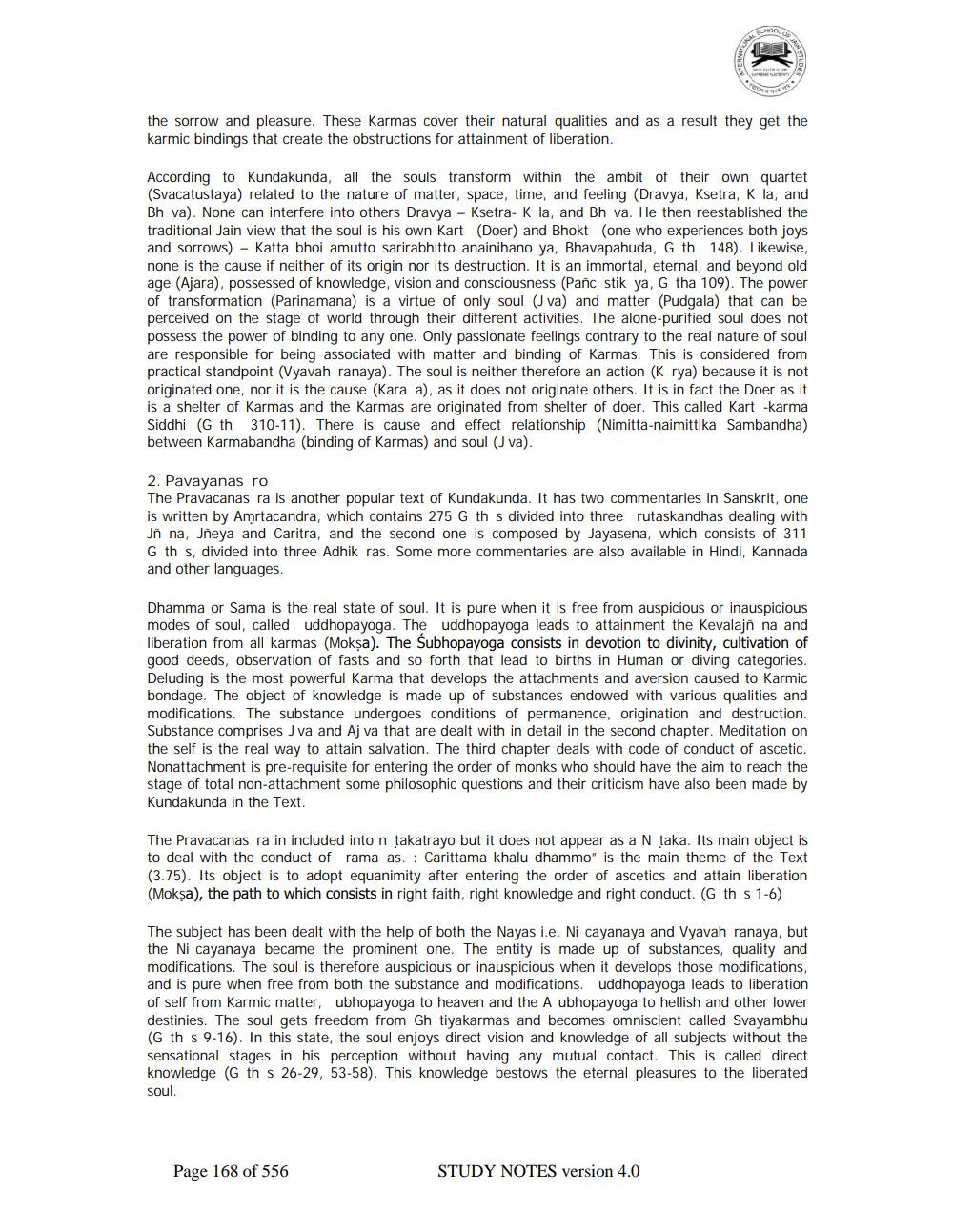________________
the sorrow and pleasure. These Karmas cover their natural qualities and as a result they get the karmic bindings that create the obstructions for attainment of liberation.
According to Kundakunda, all the souls transform within the ambit of their own quartet (Svacatustaya) related to the nature of matter, space, time, and feeling (Dravya, Ksetra, Kla, and Bh va). None can interfere into others Dravya - Ksetra- Kla, and Bh va. He then reestablished the traditional Jain view that the soul is his own Kart (Doer) and Bhokt (one who experiences both joys and sorrows) - Katta bhoi amutto sarirabhitto anainihano ya, Bhavapahuda, G th 148). Likewise, none is the cause if neither of its origin nor its destruction. It is an immortal, eternal, and beyond old age (Ajara), possessed of knowledge, vision and consciousness (Pañc stik ya, G tha 109). The power of transformation (Parinamana) is a virtue of only soul (J va) and matter (Pudgala) that can be perceived on the stage of world through their different activities. The alone-purified soul does not possess the power of binding to any one. Only passionate feelings contrary to the real nature of soul are responsible for being associated with matter and binding of Karmas. This is considered from practical standpoint (Vyavah ranaya). The soul is neither therefore an action (K rya) because it is not originated one, nor it is the cause (Kara a), as it does not originate others. It is in fact the Doer as it is a shelter of Karmas and the Karmas are originated from shelter of doer. This called Kart karma Siddhi (G th 310-11). There is cause and effect relationship (Nimitta-naimittika Sambandha) between Karmabandha (binding of Karmas) and soul (J va).
2. Pavayanas ro The Pravacanas ra is another popular text of Kundakunda. It has two commentaries in Sanskrit, one is written by Amrtacandra, which contains 275 G th s divided into three rutaskandhas dealing with un na, Jneya and Caritra, and the second one is composed by Jayasena, which consists of 311 Gth s, divided into three Adhik ras. Some more commentaries are also available in Hindi, Kannada and other languages.
Dhamma or Sama is the real state of soul. It is pure when it is free from auspicious or inauspicious modes of soul, called uddhopayoga. The uddhopayoga leads to attainment the Kevalajn na and liberation from all karmas Moksa). The Subhopayoga consists in devotion to divinity, cultivation of good deeds, observation of fasts and so forth that lead to births in Human or diving categories. Deluding is the most powerful Karma that develops the attachments and aversion caused to Karmic bondage. The object of knowledge is made up of substances endowed with various qualities and modifications. The substance undergoes conditions of permanence, origination and destruction. Substance comprises J va and Aj va that are dealt with in detail in the second chapter. Meditation on the self is the real way to attain salvation. The third chapter deals with code of conduct of ascetic. Nonattachment is pre-requisite for entering the order of monks who should have the aim to reach the stage of total non-attachment some philosophic questions and their criticism have also been made by Kundakunda in the Text.
The Pravacanas ra in included into n takatrayo but it does not appear as a N taka. Its main object is to deal with the conduct of rama as. : Carittama khalu dhammo" is the main theme of the Text (3.75). Its object is to adopt equanimity after entering the order of ascetics and attain liberation (Mokşa), the path to which consists in right faith, right knowledge and right conduct. (G th s 1-6)
The subject has been dealt with the help of both the Nayas i.e. Ni cayanaya and Vyavah ranaya, but the Ni cayanaya became the prominent one. The entity is made up of substances, quality and modifications. The soul is therefore auspicious or inauspicious when it develops those modifications, and is pure when free from both the substance and modifications.uddhopayoga leads to liberation of self from Karmic matter, ubhopayoga to heaven and the A ubhopayoga to hellish and other lower destinies. The soul gets freedom from Gh tiyakarmas and becomes omniscient called Svayambhu (Gth s 9-16). In this state, the soul enjoys direct vision and knowledge of all subjects without the sensational stages in his perception without having any mutual contact. This is called direct knowledge (
Gth s 26-29, 53-58). This knowledge bestows the eternal pleasures to the liberated soul.
Page 168 of 556
STUDY NOTES version 4.0




